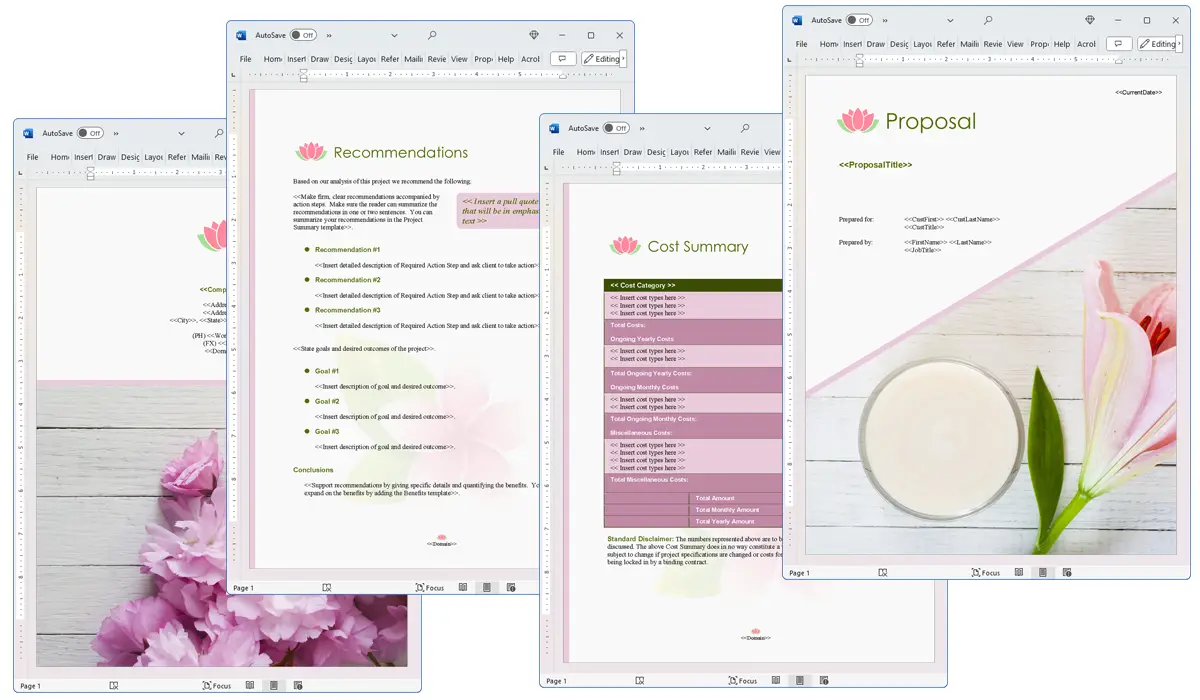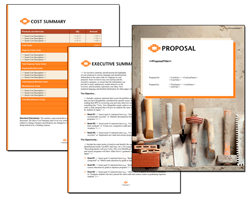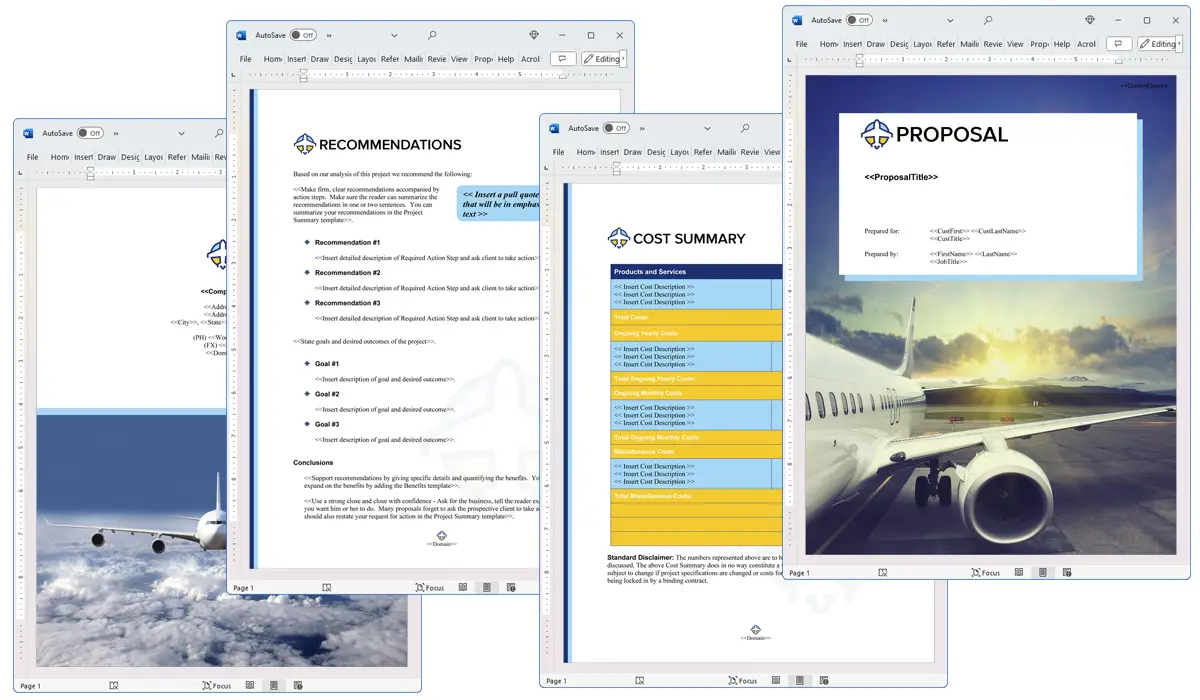What is the Accounts Receivable chapter used for?
Proposal Kit Professional Bundle adds more design themes, all six Contract Packs,
a project management library, and Expert Edition software.

Illustration of Proposal Pack Hospitality #2
We include this Accounts Receivable chapter template in every Proposal Pack, along with thousands more. You assemble this chapter with others in various combinations to create custom-tailored business proposals, plans, reports, and other documents. Proposal Packs apply custom visual designs to the templates, giving the final documents a consistent professional finish.
 DOWNLOADABLE, ONE-TIME COST, NO SUBSCRIPTION FEES
DOWNLOADABLE, ONE-TIME COST, NO SUBSCRIPTION FEES
Overview of the Accounts Receivable Chapter
The Accounts Receivable chapter is an important component for any business proposal that involves financial transactions or credit terms. This chapter is designed to provide a clear and structured summary of money that is owed to a company by its customers. By outlining detailed accounts of invoices, their due dates, the amounts that have been collected, and the remaining balances, it helps in presenting a transparent financial picture to the proposal recipients.
How is the Accounts Receivable Chapter Used?
In a business proposal, the Accounts Receivable chapter is used to support financial claims and projections. It serves as evidence of the company's financial health and its efficiency in managing credit. This chapter is particularly important when a business seeks funding, partnerships, or contracts, as it provides potential partners with insight into the company's liquidity and credit management practices. It can also be instrumental in negotiations, showcasing the company's ability to manage and collect debts effectively.
What is Included in the Accounts Receivable Chapter?
The Accounts Receivable chapter typically includes:
- List of Invoices: A detailed tabulation of all issued invoices, often presented with invoice numbers for easy reference.
- Due Dates: Specific dates on which each invoice is expected to be paid.
- Amounts Owed: The total money owed to the company per invoice at the time of the proposal.
- Amounts Collected: Payments that have been received up to the date of the proposal.
- Balances Due: Current outstanding balances, reflecting what is still owed by the customers after accounting for any payments received.
This structured format ensures that the financial data is easy to understand and analyze, providing clear insights into the company's accounts receivable status.
Use Case Examples for the Accounts Receivable Chapter
- Financial Management Proposals: When proposing new financial management software, the Accounts Receivable chapter can demonstrate the current manual processes and justify the need for automation.
- Business Loan Applications: In proposals for business loans, this chapter can illustrate the company's incoming cash flow and its reliability in debt repayment.
- Partnership Agreements: For potential partnerships, this chapter shows how the business handles credit and collections, crucial for assessing financial stability.
- Investment Proposals: Investors looking at the proposal can assess the credit health and operational efficiency of the company through this chapter.
- Contract Bids: In contract bids, particularly for large projects, this chapter can help in proving the company's financial robustness and its ability to manage large-scale credits.
Key Takeaways
- The Accounts Receivable chapter is vital for showcasing a company's financial health and credit management.
- It includes detailed information on invoices, payments, and outstanding balances.
- This chapter supports financial transparency in business proposals.
- It is important in proposals focusing on financial negotiations, such as loans or investments.
- Effective use of the Accounts Receivable chapter can enhance trust and credibility in business relationships.

Illustration of Proposal Pack Construction #8
 What Our Clients Say
What Our Clients SayThe Proposal Kit has helped me with the very basics of getting started. The templates are ones that are real world value and is a must for all businesses that want to bring about a change in the way you promote and grow your business."
 4.7 stars, based on 845 reviews
4.7 stars, based on 845 reviewsRelated Chapters

The Accounts Receivable chapter and other chapters are integrated into a Word document as illustrated here in the Proposal Pack Aerospace #3 design theme. There are hundreds of design themes available, and every design theme includes the Accounts Receivable chapter template.
A proper business proposal will include multiple chapters. This chapter is just one of many you can build into your proposal. We include the complete fill-in-the-blank template in our Proposal Pack template collections. We also include a library of sample proposals illustrating how companies in different industries, both large and small, have written proposals using our Proposal Packs. This template will show you how to write the Accounts Receivable.
We include a chapter library for you to build from based on your needs. All proposals are different and have different needs and goals. Pick the chapters from our collection and organize them as needed for your proposal.
Using the Proposal Pack template library, you can create any business proposal, report, study, plan, or document.
 Ian Lauder has been helping businesses write their proposals and contracts for two decades. Ian is the owner and founder of Proposal Kit, one of the original sources of business proposal and contract software products started in 1997.
Ian Lauder has been helping businesses write their proposals and contracts for two decades. Ian is the owner and founder of Proposal Kit, one of the original sources of business proposal and contract software products started in 1997.By Ian Lauder
 Published by Proposal Kit, Inc.
Published by Proposal Kit, Inc.


 Cart
Cart
 Facebook
Facebook YouTube
YouTube X
X Search Site
Search Site